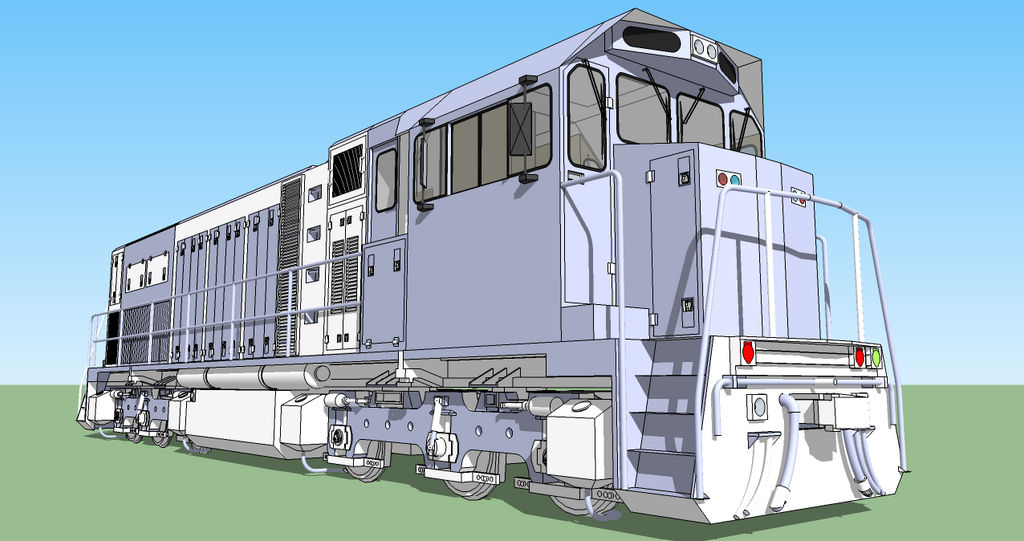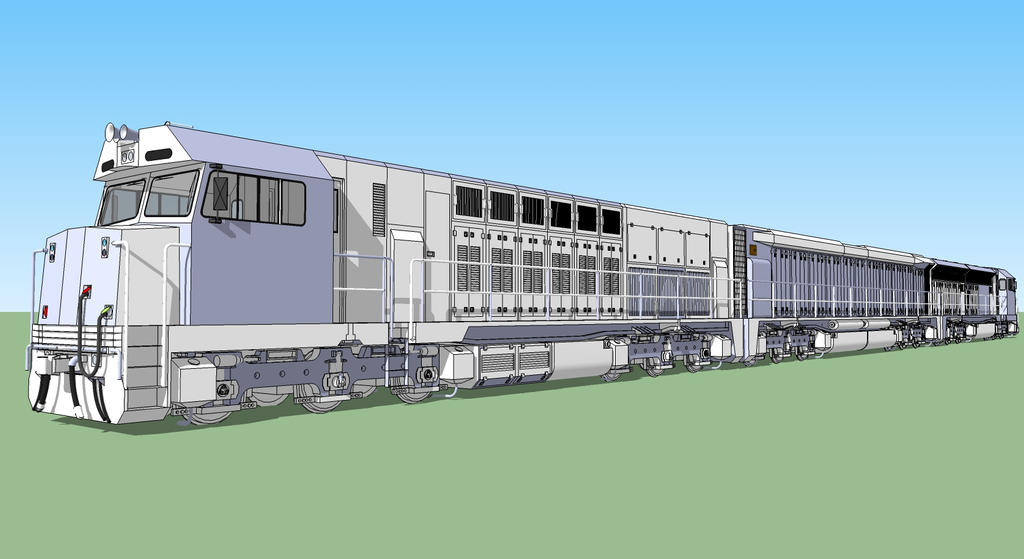@Andrew Boyd. Here´s my ideas for Southern Pacific.
During the New Deal program of President Roosevelt, many works occur along the US infrastructure systems. On railroads side, on West Coast, the Southern Pacific came if project of new mainline link L.A. to San Francisco and Sacramento, and extended the L.A. – San Diego Air Line. This route became the Ventura Corridor express mainline, use part of San Joaquin Valley Line and based on Northeastern Corridor of PRR.
Begin the construction in 1933, the route are entire complete just before WW2 in 1939, and make one of great engineering projects at the time. On Bay Area, the new massive Bay Terminal Station based on Bauhaus style are built on South Park, on site of old Transbay Terminal from Key System and became the main station for Southern Pacific, Union Pacific, ATSF and for the Key System, together if a new link of Key over the recently-built Golden Gate bridge.
The Ventura Corridor are built in a very modern standart, as trains could run up to 180 kph by late 40s, have concrete ties, C.T.C. and electric sinalization. As way to compete if Union Pacific City of San Francisco and Boston & Western Streamliners, the Southern Pacific launch a new higher speed EMUs use on introduce California Vista service on San Diego – L.A. and San Francisco, as together if existing Daylight that pass to use the corridor. The trainsets are built in cooperation if Pullman and ALCO, as the DSL-30 Higher Speed Units.

ALCO DSL-30 in Daylight Livery
By 1949, the SP entire Coast Division are electrifield, and SP pass all they commuter and intercity passenger operations to Pacific Electric. For this, P.E. introduce a new streamliner express EMU, built by GE in 1950, the EXS-42 California Vista became the first on a serie of express trains operate on CA by SP and became a vital commuter route until the opening of CAHSR by late 80s. For freight operations, in 1952, SP bought 40 units GE EP-300 "Little Joe", for use on freight and pull the Daylight under the wires.

Little Joe in Daylight Livery

Little Joe Black Window scheme

GE EXS-42 Streamliner EMU. Consist make of 8-cars, full air-conditioned, Pullman design interiors and top speed ok 200 kph.
In 1956, City of S.F. and Southern Pacific begin talks to what became the today BART, based on the idea for new massive subway system based on L.A. and NYC, if express and commuter service. Together, the Key System network now are part of SP and begin upgrades for light rail operations, as entire route duplication, remove of street running and built of a new 4x Transbay Tunnel in 1960.
1951 - 1961, Southern Pacific upgrade the routes L.A. - Phoenix - El Passo / Sacramento - Ogden / Sacramento - Portland and introduce they higher speed DMUs DXP trainsets on them. These lines are now entire duplicated, if bypass for freights and passenger and permit speeds of 200 kph, make intercity travel common.

GE DXP-55 Higher Speed Diesel trainset
After the American High Speed Act of 1967, Southern Pacific begin the operations of GE/Budd Electra Trainsets on S.F. - San Diego via L.A. route. The trains are used on Sunshine Commuter service and Hollywood Liner create by SP in early 70s. 1985 begin the construction of California High Speed Rail, a newly route built entire segregated from existing Ventura Corridor, if operation inspired on Shinkansen Bullet Train. The commercial operation CHSR begin in 1993 between San Diego and San Francisco. In 2001, the system are expanded to Phoenix, Sacramento and Las Vegas.

First generation of HSR used on CHSR, the XA-100, made by Budd, GE and Hitachi, that are derivated from original Shinkansen Series 100.
During the New Deal program of President Roosevelt, many works occur along the US infrastructure systems. On railroads side, on West Coast, the Southern Pacific came if project of new mainline link L.A. to San Francisco and Sacramento, and extended the L.A. – San Diego Air Line. This route became the Ventura Corridor express mainline, use part of San Joaquin Valley Line and based on Northeastern Corridor of PRR.
Begin the construction in 1933, the route are entire complete just before WW2 in 1939, and make one of great engineering projects at the time. On Bay Area, the new massive Bay Terminal Station based on Bauhaus style are built on South Park, on site of old Transbay Terminal from Key System and became the main station for Southern Pacific, Union Pacific, ATSF and for the Key System, together if a new link of Key over the recently-built Golden Gate bridge.
The Ventura Corridor are built in a very modern standart, as trains could run up to 180 kph by late 40s, have concrete ties, C.T.C. and electric sinalization. As way to compete if Union Pacific City of San Francisco and Boston & Western Streamliners, the Southern Pacific launch a new higher speed EMUs use on introduce California Vista service on San Diego – L.A. and San Francisco, as together if existing Daylight that pass to use the corridor. The trainsets are built in cooperation if Pullman and ALCO, as the DSL-30 Higher Speed Units.
ALCO DSL-30 in Daylight Livery
By 1949, the SP entire Coast Division are electrifield, and SP pass all they commuter and intercity passenger operations to Pacific Electric. For this, P.E. introduce a new streamliner express EMU, built by GE in 1950, the EXS-42 California Vista became the first on a serie of express trains operate on CA by SP and became a vital commuter route until the opening of CAHSR by late 80s. For freight operations, in 1952, SP bought 40 units GE EP-300 "Little Joe", for use on freight and pull the Daylight under the wires.
Little Joe in Daylight Livery
Little Joe Black Window scheme
GE EXS-42 Streamliner EMU. Consist make of 8-cars, full air-conditioned, Pullman design interiors and top speed ok 200 kph.
In 1956, City of S.F. and Southern Pacific begin talks to what became the today BART, based on the idea for new massive subway system based on L.A. and NYC, if express and commuter service. Together, the Key System network now are part of SP and begin upgrades for light rail operations, as entire route duplication, remove of street running and built of a new 4x Transbay Tunnel in 1960.
1951 - 1961, Southern Pacific upgrade the routes L.A. - Phoenix - El Passo / Sacramento - Ogden / Sacramento - Portland and introduce they higher speed DMUs DXP trainsets on them. These lines are now entire duplicated, if bypass for freights and passenger and permit speeds of 200 kph, make intercity travel common.
GE DXP-55 Higher Speed Diesel trainset
After the American High Speed Act of 1967, Southern Pacific begin the operations of GE/Budd Electra Trainsets on S.F. - San Diego via L.A. route. The trains are used on Sunshine Commuter service and Hollywood Liner create by SP in early 70s. 1985 begin the construction of California High Speed Rail, a newly route built entire segregated from existing Ventura Corridor, if operation inspired on Shinkansen Bullet Train. The commercial operation CHSR begin in 1993 between San Diego and San Francisco. In 2001, the system are expanded to Phoenix, Sacramento and Las Vegas.
First generation of HSR used on CHSR, the XA-100, made by Budd, GE and Hitachi, that are derivated from original Shinkansen Series 100.



